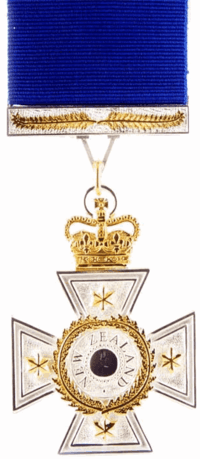New Zealand Cross (1999)
| New Zealand Cross | |
|---|---|
 Obverse of the Cross, and Ribbon: 38mm, bright blue. | |
| Awarded by New Zealand | |
| Type | Civil decoration |
| Eligibility | New Zealand Civilians, but may also be awarded to New Zealand military personnel in some circumstances |
| Awarded for | "... acts of great bravery in situations of extreme danger"[1] |
| Status | Currently awarded |
| Statistics | |
| Established | 20 September 1999 |
| First awarded | 1999 |
| Last awarded | 1999 |
| Total awarded | 2 |
| Precedence | |
| Next (higher) | Highest |
| Equivalent | Victoria Cross for New Zealand |
| Next (lower) | New Zealand Bravery Star |
The New Zealand Cross (NZC) is New Zealand's highest award for civilian bravery. It was instituted by Royal Warrant on 20 September 1999 [2] as part of the move to replace British bravery awards with an indigenous New Zealand Bravery system. The medal, which may be awarded posthumously, is granted in recognition of "acts of great bravery in situations of extreme danger". The medal is primarily a civilian award, but it is also awarded to members of the armed forces who perform acts of bravery in non-operational circumstances (given that the New Zealand gallantry awards may only be awarded "while involved in war and warlike operational service (including peacekeeping)".[3]
Bars are awarded to the NZC in recognition of the performance of further acts of bravery meriting the award. Recipients are entitled to the postnominal letters NZC. This medal replaced the award of the George Cross in respect of acts of bravery in, or meriting recognition by, New Zealand. The design of this medal was based on the original New Zealand Cross (1869), though with a change of ribbon color to differentiate it from the Victoria Cross.
Appearance
The New Zealand Cross is similar in design to the original New Zealand Cross (1869). The decoration is a silver cross pattée, 52 millimetres high, 38 millimetres wide, with six-pointed gold star on each limb. In the centre there are the words 'New Zealand' within a gold fern wreath. The cross surmounted by gold Royal crown which is attached by a ring and a seriffed 'V' to a bar ornamented with gold fern leaves, through which the ribbon passes. On the reverse "FOR BRAVERY - MO TE MAIA" is inscribed.
Recipients of the New Zealand Cross
Jacinda Margaret Amey [4]
On 24 April 1992 Ms Amey was one of five members of a Meteorological Service team, stationed on the remote sub-Antarctic Campbell Island, who were snorkelling when one of them, Mr Mike Fraser, was attacked by a shark, believed to be a white pointer. The other swimmers, apart from Ms Amey, swam to shore. Ms Amey waited until the shark moved away from Mr Fraser and then went to his aid and towed him to shore. Mr Fraser had lost his right forearm and his left forearm was severely lacerated and appeared to be broken. He was having trouble breathing and required urgent medical treatment. Having got him to shore, Ms Amey then joined the rest of the team in doing what they could for Mr Fraser until he could be flown to New Zealand. Ms Amey displayed great courage and bravery with complete disregard for her own safety in going to Mr Fraser's assistance.
Reginald John Dixon [5]
On 9 June 1995, Mr Dixon, aged 47, and his wife were passengers on Ansett New Zealand Flight 703 when the aircraft crashed in the Tararua Ranges near Palmerston North. Mr Dixon escaped from the wreckage with fractures. However, despite his injuries, he returned to the aircraft to help other passengers trapped in the wreckage. As a result of this selfless action, he was critically burned when a flash fire broke out on the left wing of the aircraft near a hole in the fuselage from which he was helping passengers escape. He was hospitalised and underwent surgery and skin grafts. Mr Dixon remained in a coma, and although he made some initial improvement, his condition worsened and he died two weeks later, the fourth victim of the crash. The situation in which Mr Dixon found himself was extremely dangerous and he displayed great bravery in returning to the aircraft, although injured, to help other passengers which subsequently resulted in the loss of his own life. His bravery undoubtedly ensured that the loss of life was not greater.
See also
- Orders, decorations, and medals of New Zealand
- New Zealand gallantry awards
- New Zealand bravery awards
- New Zealand campaign medals
Notes
- ↑ "New Zealand Gallantry and Bravery Awards". NZ Ministry of Defence. Retrieved 2007-10-15.
- ↑ "The New Zealand Bravery Awards Royal Warrant". NZ Ministry of Defence. Retrieved 2007-10-15.
- ↑ "The New Zealand Gallantry Awards Royal Warrant". NZ Ministry of Defence. Retrieved 2007-10-15.
- ↑ "Recipients of the New Zealand Cross - Jacinda Amey". NZ Ministry of Defence. Retrieved 2007-10-15.
- ↑ "Recipients of the New Zealand Cross - John Dixon". NZ Ministry of Defence. Retrieved 2007-10-15.